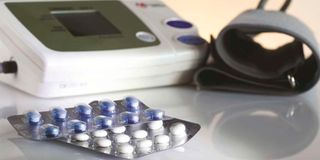Hypertension a ticking time bomb, report shows

Hypertension pills with equipment for measuring blood pressure in the background.
What you need to know:
- Kemri report reveals only the rich have easy access to screening and treatment.
- High blood pressure is informally referred to as a ‘silent killer’ because it has no warning signs.
It’s nearly impossible for a majority of Kenyans to access screening for hypertension despite its prevalence in informal settlements and rural areas across the country, says the Kenya Medical Research Institute.
High blood pressure is informally referred to as a ‘silent killer’ because the disease has no warning signs or symptoms, yet if left unchecked, it could lead to disastrous consequences. A new Kemri report now shows that the rich have easy access to screening as well as treatment.
A member of the Health Economics Research Unit at Kemri, Mr Robinson Oyando, said non-communicable diseases (NCDs) account for 50 per cent of hospitalisations and 55 per cent of inpatient deaths in the country.
“Hypertension is one of the major NCDs in Kenya. Equitable access and utilisation of screening and treatment interventions are critical for reducing the burden of hypertension,” he told the Nation yesterday.
He said their study assessed horizontal equity (equal treatment for equal need) in the screening and treatment for hypertension.
“We sought to find out how equal the screening and treatment procedures are. For screening and treatment in terms of equity, we found that it is poor individuals who need screening but the rich ones get access to this service more,” said Mr Oyando.
Hypertension screening
“However, rich Kenyans need the treatment more. The burden of hypertension is real even as rich individuals use more screening and treatment interventions beyond what they necessarily need,” he added.
The study used the most recent and nationally representative cross-sectional STEPwise survey (STEPs) conducted by the Kenya National Bureau of Statistics between April and June 2015 in all the 47 counties.
The socioeconomic status was measured using several approaches, classified as ‘direct measures’ ,that is, expenditure, income, consumption; and ‘proxy measures’, including education, occupation or social class, but mainly asset indices.
“The need for hypertension screening was defined as individuals who smoke, are obese and are 30 years and above (for both men and women), as stipulated in Kenya’s cardiovascular treatment guidelines. We sampled 6,000 households. Out of these, 4,754 participated,” said Mr Oyando.
“We established that women are more open to seeking screening and treatment services compared to men which makes gender as one of the things that is contributing to the inequality. Given that hypertension is more asymptomatic and given the economic responsibilities of men, they may not give their own health a priority,” he added.
Serious condition
The researchers urge the national and county governments to prioritise hypertension screening and treatment. “Counties need to invest more in primary healthcare facilities and ensure they are well-equipped to provide quality services; they also need to create awareness so that more people show up for screening,” said Mr Oyando.
“There is no standard cost for treating hypertension as it depends on the nature of the case being handled and the fact that different facilities charge different fees but what makes it expensive is medicine and transportation to access this facility, especially for poor people,” he added.
According to the World Health Organization (WHO), hypertension is a serious condition that significantly increases the risks of heart, brain, kidney and other diseases.
About 1.28 billion adults aged 30-79 years worldwide have hypertension, most (two-thirds) living in low and middle-income countries.
Modifiable risk factors include unhealthy diets (excessive salt consumption, a diet high in saturated fat and trans fats, low intake of fruits and vegetables), physical inactivity, consumption of tobacco and alcohol, and being overweight or obese.
Non-modifiable risk factors include a family history of hypertension, age over 65 years and co-existing diseases such as diabetes or kidney disease,” WHO says. Severe hypertension can cause fatigue, nausea, vomiting, confusion, anxiety, chest pain and muscle tremors.





